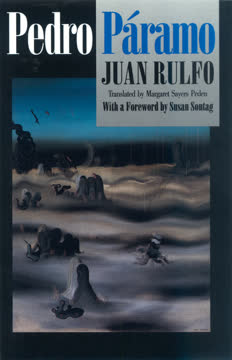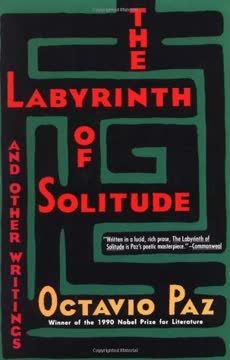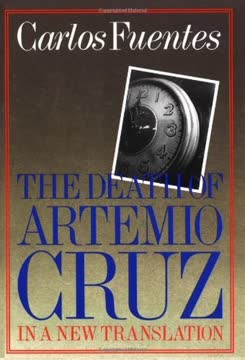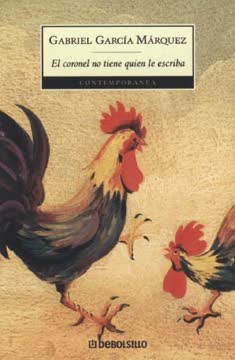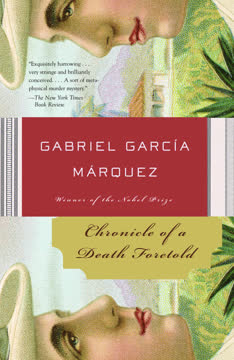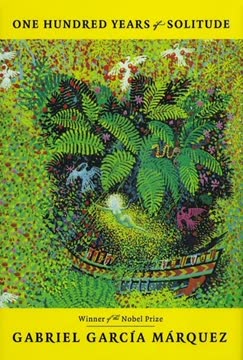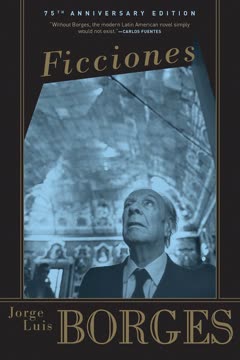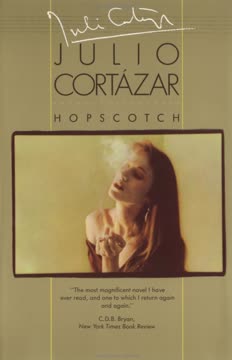Plot Summary
Journey to Comala's Ghosts
Juan Preciado, honoring his dying mother Dolores's wish, travels to the town of Comala to find his estranged father, Pedro Páramo. He arrives expecting a place of nostalgia and hope, but instead finds a sun-scorched, desolate village haunted by silence and decay. Guided by a mysterious muleteer, Abundio, who claims also to be Pedro's son, Juan learns that his father is long dead and that Comala is a place where the living and the dead intermingle. The journey is not just physical but metaphysical, as Juan is drawn into a world where time, memory, and reality blur, and the boundaries between life and death dissolve.
Echoes in Empty Streets
Juan wanders through Comala's abandoned streets, encountering spectral figures and hearing voices from the past. The town is populated by echoes—memories and regrets of those who once lived there. He meets Eduviges Dyada, who seems to have been expecting him, and learns that the dead in Comala are unable to rest, trapped by unfinished business and unspoken sorrows. The town's emptiness is an illusion; it is crowded with the murmurs of the dead, each reliving their pain and longing for redemption or release.
The Woman Who Waited
Eduviges Dyada, a friend of Juan's mother, recounts stories of love, betrayal, and the oppressive presence of Pedro Páramo. She tells Juan about his mother's suffering and the broken promises that led to her departure from Comala. Eduviges's own life is marked by loneliness and a longing for death, reflecting the pervasive despair of the town. Through her, Juan glimpses the tangled web of relationships and the emotional debts that bind the souls of Comala.
Pedro Páramo's Rise
Flashbacks reveal Pedro Páramo's ascent from a neglected child to the all-powerful cacique of Comala. Manipulative and ambitious, he consolidates land and power through cunning, violence, and exploitation. His marriage to Dolores is a transaction, not a union of love, and he leaves a trail of abandoned lovers and illegitimate children. Pedro's rule brings prosperity to himself but misery to others, sowing the seeds of the town's eventual ruin.
Sighs and Abandonment
Dolores, Juan's mother, is driven from Comala by Pedro's indifference and cruelty. Her life becomes a series of sighs—expressions of longing and regret. She raises Juan in poverty, haunted by memories of a lost home and a love that was never reciprocated. Her deathbed wish for Juan to confront his father is both an act of vengeance and a desperate hope for closure.
The Town of the Dead
As Juan seeks shelter, he realizes that the people he meets—Damiana, Donis, Dorotea—are all dead, trapped in a liminal state. Their stories intertwine, revealing a community bound by guilt, unfulfilled desires, and the inability to move on. The living are outnumbered by the dead, and the town itself becomes a purgatory where time loops endlessly and suffering is inescapable.
The Tyrant's Domain
Pedro Páramo's grip on Comala is absolute. He manipulates the priest, Father Rentería, and uses violence to eliminate rivals. His son Miguel, a product of his own amorality, terrorizes the town with impunity. Pedro's actions poison the land and the people, turning Comala into a place of fear and spiritual desolation. His pursuit of Susana San Juan, the woman he truly loves, is obsessive and ultimately destructive.
Love and Madness: Susana
Susana, Pedro's childhood love, returns to Comala after years of suffering and loss. Traumatized by her past and the death of her first husband, she descends into madness, unable to reciprocate Pedro's love. Her inner world is filled with memories, hallucinations, and a longing for escape. Pedro's attempts to possess her only deepen her isolation, and her death marks the final collapse of his hopes and the town's last chance for renewal.
The Priest's Compromises
Father Rentería, the town's priest, is complicit in Pedro's tyranny. He accepts bribes, withholds absolution from the poor, and is tormented by his own impotence and guilt. His inability to provide spiritual guidance or justice contributes to the town's damnation. The church, meant to be a source of salvation, becomes another instrument of oppression and despair.
Miguel's Sins and Death
Miguel Páramo, Pedro's illegitimate son, embodies the worst traits of his father—cruelty, lust, and recklessness. His crimes, including rape and murder, go unpunished until his own violent death. The town's reaction to his passing is ambivalent, reflecting both relief and the deep scars left by his actions. His death is a turning point, signaling the beginning of the end for Pedro and Comala.
The Murmuring Earth
Overwhelmed by fear and the relentless murmurs of the dead, Juan Preciado dies of fright and suffocation. He is buried in a communal grave with Dorotea, and together they listen to the endless voices of Comala's dead. The earth itself seems alive with memories, regrets, and confessions, a testament to the unresolved pain that binds the town.
Revolution and Ruin
The Mexican Revolution and subsequent conflicts reach Comala, bringing further chaos and destruction. Pedro Páramo manipulates the revolutionaries for his own ends, but the social upheaval ultimately undermines his power. The town's remaining inhabitants flee or perish, and the land becomes barren. The revolution, instead of bringing justice, leaves only more ghosts and broken dreams.
The Collapse of Comala
After Susana's death, Pedro Páramo, consumed by grief and spite, vows to let Comala die. He withholds resources, causing famine and mass exodus. The once-thriving town becomes a wasteland, its fate sealed by the very man who once ruled it. The cycle of suffering is complete, and Comala is left to the dead.
The Last Hope Dies
Susana's passing is marked not by mourning but by celebration, as the townspeople, oblivious or indifferent, hold a festival. Her death is the last blow to Pedro's spirit and the final extinguishing of hope for Comala. The bells toll endlessly, but no prayers can redeem the town or its people.
The End of Pedro Páramo
Pedro Páramo, abandoned and broken, sits alone in his ruined estate. Haunted by memories and regrets, he is finally killed by Abundio, another of his neglected sons, who seeks help to bury his own wife. Pedro's death is anticlimactic—a quiet collapse rather than a dramatic reckoning. His legacy is one of emptiness and ruin.
Buried Voices Remain
Even after Pedro's death, the voices of Comala's dead persist. Juan and Dorotea, buried together, listen to the endless confessions, laments, and memories that fill the earth. The town's story is not one of redemption but of perpetual unrest, as the dead remain trapped by the weight of their earthly sins and sorrows.
The Cycle of Suffering
The novel closes with the sense that Comala's suffering is eternal, a cycle fueled by human failings—greed, cruelty, and the inability to forgive or let go. The boundaries between past and present, life and death, are forever blurred. The story is both a lament for a lost world and a cautionary tale about the consequences of unchecked power and unhealed wounds.
Characters
Juan Preciado
Juan is the novel's primary narrator and the reader's guide into Comala's spectral world. Driven by a promise to his dying mother, he arrives in Comala seeking his father but instead finds only ghosts and echoes. Juan's journey is both literal and existential; he is a passive observer, overwhelmed by the weight of the town's collective memory. His psychological arc moves from hope to confusion, fear, and finally resignation as he succumbs to the murmurs of the dead. In death, he becomes a witness to the endless cycle of suffering that defines Comala.
Pedro Páramo
Pedro is the central figure whose actions shape the fate of Comala. Orphaned and emotionally stunted, he rises to power through manipulation, violence, and exploitation. His relationships are transactional, except for his obsessive love for Susana San Juan, which remains unfulfilled and ultimately destroys him. Pedro is both a victim and perpetrator of the town's misery, embodying the destructive potential of unchecked authority and unresolved longing. His psychological complexity lies in his capacity for both cruelty and vulnerability, especially in his final years of isolation and regret.
Dolores Preciado
Dolores is Juan's mother and Pedro's abandoned wife. Her life is marked by disappointment, nostalgia, and unrequited love. She represents the emotional cost of Pedro's ambition and the generational transmission of suffering. Her dying wish sets the novel's events in motion, and her presence lingers as a voice of memory and loss, shaping Juan's perceptions and the reader's understanding of Comala's tragedy.
Susana San Juan
Susana is the object of Pedro's lifelong obsession and the novel's most enigmatic character. Traumatized by her past and the loss of her first husband, she retreats into madness, unable to connect with the world around her. Her inner life is a swirl of memories, hallucinations, and sensual longing, making her both a victim and a symbol of unattainable desire. Susana's death marks the final collapse of hope for both Pedro and Comala.
Father Rentería
Father Rentería is the spiritual leader of Comala, but his moral authority is undermined by his dependence on Pedro and his own sense of guilt. He withholds absolution from the poor, accepts bribes, and is tormented by his inability to save his flock or himself. Rentería's psychological struggle reflects the broader theme of spiritual decay and the failure of institutions to provide redemption.
Eduviges Dyada
Eduviges is a spectral figure who welcomes Juan to Comala and serves as a link between the living and the dead. Her life is marked by unfulfilled love and a longing for death, mirroring the town's pervasive despair. She embodies the theme of promises unkept and the persistence of memory beyond the grave.
Dorotea (La Cuarraca)
Dorotea is a marginalized woman who believes she has a child, though it is only a bundle of rags. In death, she shares a grave with Juan and becomes his companion in the afterlife. Her delusions and longing for motherhood reflect the novel's themes of loss, illusion, and the search for meaning in suffering.
Miguel Páramo
Miguel is Pedro's illegitimate son, notorious for his cruelty and lawlessness. His unchecked violence terrorizes Comala, and his death is both a relief and a symbol of the consequences of Pedro's legacy. Miguel's actions deepen the town's wounds and hasten its decline.
Abundio Martínez
Abundio is another of Pedro's unacknowledged sons, a muleteer who guides Juan to Comala. His life is marked by poverty, loss, and desperation. In the end, driven mad by grief, he kills Pedro, bringing the tyrant's reign to a quiet, ignoble end. Abundio's story underscores the generational cycle of abandonment and suffering.
Damiana Cisneros
Damiana is a servant at the Media Luna and one of the few who shows kindness to Juan. She is a stabilizing presence amid chaos, but even she is ultimately revealed to be a ghost, another victim of Comala's fate. Her role highlights the blurred line between life and death and the persistence of memory.
Plot Devices
Nonlinear, Fragmented Narrative
Rulfo structures the novel as a collage of voices, memories, and flashbacks, refusing a straightforward timeline. This fragmentation reflects the psychological and spiritual disintegration of Comala and its people. The reader is forced to piece together the story from overlapping perspectives, mirroring the characters' own confusion and inability to escape the past.
Blurring of Life and Death
The novel's most striking device is its seamless blending of the living and the dead. Characters speak from beyond the grave, and the boundaries between memory, dream, and reality are porous. This creates a haunting, dreamlike atmosphere and emphasizes the persistence of unresolved trauma.
Echoes and Murmurs
The motif of murmuring—whispers, echoes, and confessions—pervades the novel. These sounds represent the weight of collective guilt and the inability to find peace. The earth itself seems alive with the voices of the dead, reinforcing the sense of a world trapped in perpetual unrest.
Symbolic Landscape
The setting is both literal and symbolic: a sun-baked, barren town that serves as a metaphor for spiritual desolation and purgatory. The oppressive heat, dust, and silence mirror the characters' internal states and the consequences of Pedro's tyranny.
Foreshadowing and Circularity
The narrative is filled with foreshadowing—deaths are foretold, and characters' fates are sealed by their own actions. The story's circular structure, with its repeated motifs and unresolved endings, suggests that Comala's suffering is inescapable and eternal.
Analysis
Pedro Páramo is a masterwork of Latin American literature, blending elements of magical realism, modernist fragmentation, and folk legend to create a haunting meditation on power, memory, and the afterlife. Rulfo's Comala is both a real place and a metaphysical purgatory, where the sins of the past echo endlessly and redemption is elusive. The novel critiques the abuses of authority—political, familial, and religious—while exploring the psychological costs of longing, abandonment, and unfulfilled desire. Its nonlinear structure and chorus of voices force the reader to confront the instability of truth and the persistence of trauma. Ultimately, Pedro Páramo is a warning about the dangers of unchecked power and the necessity of confronting the past; it is a lament for a lost world and a testament to the enduring power of storytelling to give voice to the silenced and the forgotten.
Last updated:
FAQ
Synopsis & Basic Details
What is Pedro Páramo about?
- A Son's Quest: The novel follows Juan Preciado, who journeys to the desolate, ghost-ridden town of Comala to fulfill a deathbed promise to his mother: to find his estranged father, Pedro Páramo. This initial quest quickly transforms into a descent into a spectral world where the boundaries between life and death are porous.
- Comala's Haunting Reality: Upon arrival, Juan discovers that Comala is a literal wasteland, populated by the murmuring voices of the dead, each trapped by their unresolved pasts and the legacy of Pedro Páramo's tyranny. His search for a living father becomes an encounter with a town that is itself a purgatory.
- The Tyrant's Legacy: The narrative interweaves Juan's present-day experiences with flashbacks revealing the rise and fall of Pedro Páramo, a ruthless cacique who amassed power through violence, manipulation, and exploitation, ultimately leading to the spiritual and physical ruin of Comala.
Why should I read Pedro Páramo?
- Pioneering Magical Realism: Juan Rulfo's novel is a foundational text of magical realism, seamlessly blending the supernatural with the mundane, creating a haunting and dreamlike atmosphere that influenced generations of Latin American writers, including Gabriel García Márquez.
- Masterful Narrative Structure: Its fragmented, non-linear narrative, shifting perspectives, and blurring of time challenge readers to actively piece together the story, offering a unique and deeply immersive literary experience that rewards close attention.
- Profound Thematic Depth: Beyond its captivating plot, "Pedro Páramo" delves into universal themes of power, corruption, unrequited love, memory, guilt, and the afterlife, offering a powerful critique of social injustice and the enduring consequences of human actions.
What is the background of Pedro Páramo?
- Post-Revolutionary Mexico: The novel is set against the backdrop of early 20th-century Mexico, spanning the Porfirio Díaz dictatorship, the Mexican Revolution (1910-1917), and the Cristero Revolt (1926-1929). This historical context of political upheaval and social unrest deeply informs the narrative, reflecting the breakdown of traditional structures and the rise of local strongmen like Pedro Páramo.
- Rural Jalisco's Influence: Rulfo drew heavily on the landscapes, folklore, and linguistic nuances of his native Jalisco, particularly the arid, often desolate regions. Comala, though fictional, embodies the harsh realities and spiritual desolation of many rural Mexican towns ravaged by conflict and neglect.
- Caciquismo and Land Ownership: A central theme is "caciquismo," the system of local political bosses (caciques) who wield absolute power, often through violence and land accumulation. Pedro Páramo's rise illustrates this phenomenon, highlighting the exploitation of the poor and the Church's complicity in maintaining such oppressive systems.
What are the most memorable quotes in Pedro Páramo?
- "I came to Comala because I was told my father lived here, a man named Pedro Páramo.": This opening line immediately establishes Juan Preciado's quest and the central mystery, setting a tone of determined, yet ultimately futile, searching that defines the entire narrative. It encapsulates the initial hope that quickly dissolves into the novel's spectral reality.
- "Pedro Páramo died years ago.": Uttered by the muleteer Abundio early in Juan's journey, this shocking revelation immediately subverts the reader's expectations and signals the novel's unique approach to time and existence, confirming that Juan's quest is not for a living man but for a ghost.
- "I'll cross my arms and Comala will die of hunger.": Pedro Páramo's chilling vow after Susana San Juan's death reveals the depth of his despair and vindictiveness. This quote marks his ultimate act of abandonment and revenge against the town, directly leading to Comala's desolation and its transformation into a literal ghost town.
What writing style, narrative choices, and literary techniques does Juan Rulfo use?
- Fragmented, Non-Linear Narrative: Rulfo masterfully employs a disjointed chronology, interweaving Juan Preciado's present-day journey with numerous flashbacks to Pedro Páramo's past. This "secret carpentry," as García Márquez notes, mirrors the psychological and spiritual disintegration of Comala, forcing the reader to actively reconstruct the story.
- Blurring of Life and Death: A hallmark of the novel is its seamless integration of the living and the dead, where characters converse and interact across the veil of mortality. This technique creates a haunting, dreamlike atmosphere, emphasizing the persistence of memory and unresolved suffering beyond the grave.
- Sparse, Evocative Prose: Rulfo's style is laconic and poetic, characterized by "syntactic constructions based on sentence fragments" and a frequent use of the subjunctive mood, as noted by the translator. This creates a sense of hesitation and uncertainty, reflecting the characters' bewilderment and the novel's pervasive sense of unreality and decay.
Hidden Details & Subtle Connections
What are some minor details that add significant meaning?
- Dolores's Pinhole Photograph: Juan's mother's photograph, found "full of holes, like pinpricks, with one large enough to fit your middle finger through located right where her heart should be," subtly foreshadows her emotional torment and the "witchcraft" of memory that draws Juan to Comala, symbolizing her broken heart and the destructive power of Pedro's indifference.
- The "Capitana" Weed: The muleteer's description of "La capitana" as "a plague that waits for people to leave so it can overtake their homes" is a poignant metaphor for Comala's decay. This seemingly minor detail personifies the town's abandonment, suggesting that nature itself conspires in its ruin once human life recedes.
- Susana's Cat Delusion: Susana's insistence that a cat is "doing circus tricks" and "startled me throughout the night" when Justina claims it slept with her, highlights the depth of Susana's madness and her retreat into a private, hallucinatory world. The cat becomes a symbol of her internal torment and the elusive nature of her reality.
What are some subtle foreshadowing and callbacks?
- Abundio's Early Revelation: Abundio's casual statement, "Pedro Páramo died years ago," delivered very early in Juan's journey, is a profound piece of foreshadowing that immediately redefines the nature of Juan's quest and the reality of Comala, setting the stage for the blurring of life and death.
- Eduviges's "Sixth Sense": Eduviges's ability to hear Miguel Páramo's horse and even converse with Miguel's ghost ("It was him, it was Miguel Páramo") before his death is officially announced, subtly foreshadows her own spectral nature and the pervasive presence of the dead in Comala, establishing the novel's supernatural premise.
- The Recurring "Murmuring": The initial description of Comala as a place where "the air so thin, they were easier to hear. They settled inside you, heavy," subtly foreshadows Juan's eventual death by suffocation from the "murmuring" of the dead, turning a sensory detail into a fatal force.
What are some unexpected character connections?
- Eduviges's Near-Motherhood of Juan: Eduviges's confession that she "was close to being your mother" and even slept with Pedro Páramo on Dolores's wedding night, reveals a shocking, almost incestuous, layer to the town's interconnectedness. This detail underscores the pervasive moral decay and the transactional nature of relationships under Pedro's influence, blurring familial lines.
- Donis and His Sister: The revelation that the man Juan shelters with, Donis, is in an incestuous relationship with the woman he lives with ("He's not my husband. He's my brother, although he doesn't want anyone to know it") highlights the extreme isolation and moral degradation in Comala. Their relationship symbolizes the town's abandonment by God and society, forcing its inhabitants into desperate, transgressive unions.
- Dorotea's Role in Miguel's Exploits: Dorotea, initially presented as a pitiable, deluded figure, later confesses to Father Rentería that she "was the one who got all those girls for the late Miguelito Páramo." This dark revelation exposes her complicity in Miguel's abuses, adding a disturbing layer to her character and demonstrating how even the marginalized were entangled in the town's corruption.
Who are the most significant supporting characters?
- Eduviges Dyada: More than just a welcoming ghost, Eduviges serves as Juan's initial guide into Comala's spectral reality, embodying the town's pervasive loneliness and unfulfilled desires. Her unrequited love for Pedro and her "sixth sense" make her a poignant symbol of the living dead, trapped by past promises and the inability to find peace.
- Dorotea (La Cuarraca): Juan's companion in the grave, Dorotea is a complex figure whose delusion of motherhood ("I never really had a son") reflects the town's collective longing and the illusions people cling to in the face of despair. Her confessions reveal the hidden moral compromises of Comala's inhabitants, making her a voice of both suffering and complicity.
- Fulgor Sedano: Pedro Páramo's loyal administrator, Fulgor is the pragmatic enforcer of Pedro's will, representing the instruments of the cacique's power and the moral compromises required to maintain it. His character highlights the systemic nature of Pedro's tyranny and the way individuals become complicit in widespread corruption.
Psychological, Emotional, & Relational Analysis
What are some unspoken motivations of the characters?
- Pedro Páramo's Pursuit of Susana: Beyond simple love, Pedro's obsessive pursuit of Susana San Juan is driven by a deep-seated need for control and an attempt to reclaim a lost innocence or an idealized past. His desire for her is so absolute that her madness and death lead him to abandon all other ambitions, revealing a singular, almost pathological, emotional core.
- Father Rentería's Moral Paralysis: Father Rentería's complicity with Pedro Páramo stems not just from financial dependence but from a profound spiritual crisis and self-loathing. His inability to grant absolution to himself or to truly challenge Pedro reveals a deep-seated fear and a sense of powerlessness that paralyzes his moral agency.
- Juan Preciado's Subconscious Search: While ostensibly fulfilling his mother's promise, Juan's journey is also a subconscious search for identity and belonging. His passive acceptance of the spectral reality and his eventual death by the "murmuring" suggest a deeper, perhaps inherited, longing to connect with his roots, even if those roots are in death.
What psychological complexities do the characters exhibit?
- Susana San Juan's Retreat into Madness: Susana's madness is a complex psychological defense mechanism against profound trauma, including the death of her husband Florencio and her father's exploitation. Her internal world, filled with sensual memories of the sea and fragmented visions, becomes a sanctuary from a reality she cannot bear, making her a symbol of resistance through mental escape.
- Pedro Páramo's Grief and Despair: Pedro's transformation from a ruthless, calculating tyrant to a broken, isolated figure after Susana's death reveals a surprising depth of emotional vulnerability. His decision to let Comala "die of hunger" is not just an act of vengeance but a manifestation of his profound despair and the collapse of his entire world, which was ultimately built around his unattainable love for Susana.
- Dorotea's Delusional Motherhood: Dorotea's belief in her non-existent child ("I never really had a son") is a poignant psychological coping mechanism for profound loss and unfulfilled longing. Her "blessed" and "cursed" dreams illustrate the mind's capacity to create its own reality, offering a bittersweet comfort in the face of a life devoid of genuine connection and purpose.
What are the major emotional turning points?
- Miguel Páramo's Death: Miguel's violent death is a pivotal emotional turning point for Pedro, despite his initial lack of outward grief. It marks the beginning of Pedro's realization of the cost of his actions ("I'm beginning to pay. Better to start early, to finish sooner") and foreshadows the unraveling of his empire and his own eventual demise.
- Susana San Juan's Return to Comala: Susana's return, orchestrated by Pedro, is a moment of intense emotional anticipation for him, representing his last hope for personal fulfillment. However, her descent into madness upon arrival immediately transforms this hope into a source of profound, unrequited suffering for Pedro, sealing both their tragic fates.
- Juan Preciado's Death by Murmuring: Juan's death, caused by the overwhelming "murmuring" of the dead, is the ultimate emotional climax of his journey. It signifies his complete absorption into Comala's spectral reality, a terrifying culmination of the psychological burden of the town's unresolved past and the futility of his quest.
How do relationship dynamics evolve?
- Pedro and Comala: From Control to Mutual Destruction: Pedro Páramo's relationship with Comala evolves from one of absolute control and exploitation, where he "made the laws," to one of mutual destruction. After Susana's death, his grief transforms into a vengeful abandonment, leading him to "cross my arms and Comala will die of hunger," ultimately destroying the very town he built and ruled.
- Juan and His Mother's Memory: From Promise to Understanding: Juan's relationship with his mother's memory shifts from a simple promise to a deeper, more complex understanding of her suffering and the futility of her longing. His experiences in Comala reveal the true extent of her abandonment and the "tattered sighs" that defined her life, making his quest a shared burden of sorrow.
- Father Rentería and His Faith: From Authority to Despair: Father Rentería's relationship with his priestly duties and his faith deteriorates from a position of moral authority to one of profound despair and self-condemnation. His compromises with Pedro and his inability to provide true spiritual guidance lead him to question God's will and his own salvation, culminating in his inability to grant absolution.
Interpretation & Debate
Which parts of the story remain ambiguous or open-ended?
- The Nature of Comala's Afterlife: The novel deliberately leaves ambiguous whether Comala is a literal purgatory, a metaphorical representation of a collective memory, or a psychological state induced by trauma and isolation. The seamless intermingling of living and dead characters challenges a definitive interpretation, inviting readers to ponder the boundaries of reality and the afterlife.
- The Identity of the Voices: While many voices are identifiable, the constant "murmuring" and "whispering" of the dead often blend into an indistinct chorus. It remains open to interpretation whether these are distinct, individual souls trapped in torment, or a collective consciousness of Comala's past, a single, pervasive lament.
- The Precise Chronology of Events: Rulfo's fragmented narrative and non-linear timeline make it impossible to construct a definitive, sequential plot. This ambiguity is intentional, reflecting the disorienting nature of memory and the idea that in Comala, time itself is fractured and cyclical, preventing a clear understanding of cause and effect.
What are some debatable, controversial scenes or moments in Pedro Páramo?
- Eduviges's Claim of Sleeping with Pedro: Eduviges's assertion that she slept with Pedro on his wedding night with Dolores, at Dolores's request, is highly controversial. It raises questions about consent, the nature of truth in a town of ghosts, and the extent of moral degradation. It forces readers to question the reliability of memory and the blurred lines of responsibility.
- Father Rentería's Absolution of Miguel Páramo: The priest's decision to grant absolution to Miguel Páramo, a known rapist and murderer, after receiving a bribe from Pedro, is a deeply debated moment. It highlights the corruption of the Church and the moral compromises made under tyranny, leaving readers to question the possibility of true redemption and divine justice in Comala.
- Pedro Páramo's Final Collapse: Pedro's death, described as "crumbling as if he were a pile of rocks," is anticlimactic and open to interpretation. Is it a just punishment for his tyranny, a tragic end for a man consumed by unrequited love, or a symbolic representation of the collapse of his entire world and the system he embodied? The lack of a dramatic confrontation leaves his ultimate fate ambiguous.
Pedro Páramo Ending Explained: How It Ends & What It Means
- The Tyrant's Crumbling Demise: Pedro Páramo's reign ends not with a bang, but a whimper. He is killed by Abundio Martínez, one of his many neglected sons, in a moment of drunken desperation, collapsing "as if he were a pile of rocks." This ignoble, almost accidental death symbolizes the complete disintegration of his power, his body, and the empire he built, reducing him to the very earth he exploited.
- The Perpetuity of Purgatory: Even after Pedro's death, the "murmuring" of Comala's dead continues, as Juan Preciado and Dorotea, buried together, listen to the endless voices. This signifies that the cycle of suffering, guilt, and unresolved past is not broken by the tyrant's demise. Comala remains a purgatorial space, its inhabitants forever trapped by their earthly burdens.
- A Legacy of Emptiness and Ruin: Pedro's final act of vengeance—letting Comala "die of hunger" after Susana's death—results in the town's complete desolation. His death marks the final stage of this ruin, leaving behind a landscape of emptiness and echoes. The ending underscores the novel's central themes: the destructive consequences of unchecked power, the futility of unrequited desire, and the enduring weight of a past that refuses to die.
Review Summary
Pedro Páramo is widely acclaimed as a masterpiece of magical realism. Readers praise Rulfo's haunting prose, fragmented narrative structure, and surreal depiction of a ghost town. Many find the novel challenging but rewarding, with its non-linear storytelling and blurred lines between life and death. The book's influence on Latin American literature is frequently noted, particularly its impact on Gabriel García Márquez. While some struggle with its complexity, most reviewers consider it a profound meditation on love, power, and the lingering effects of the past.
Similar Books
Download PDF
Download EPUB
.epub digital book format is ideal for reading ebooks on phones, tablets, and e-readers.
